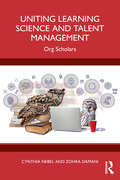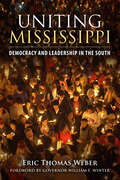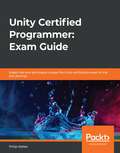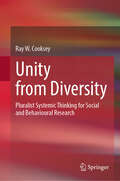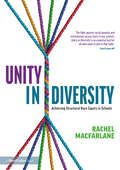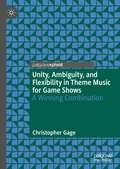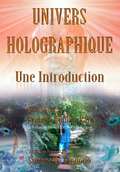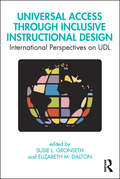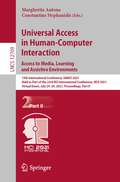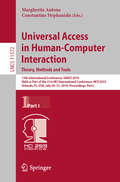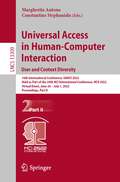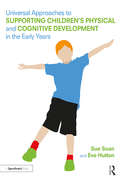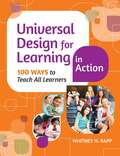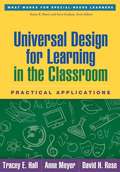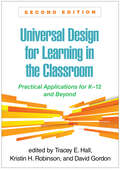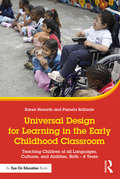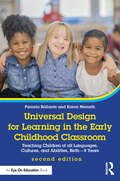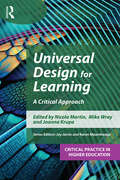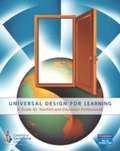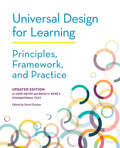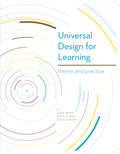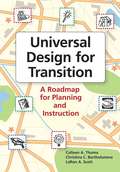- Table View
- List View
Uniting Learning Science and Talent Management: Org Scholars
by Cynthia Nebel Zohra DamaniThis book delves into the intricate relationship between the talent lifecycle and learning science, offering a fresh perspective on talent management. Through a meticulous exploration of talent acquisition, management, retention, and exits, it reveals how learning science can be harnessed to enhance organizational growth and employee satisfaction.Covering strategic talent sourcing, optimized onboarding, leadership development, and innovative retention strategies, the book presents evidence-based approaches to navigating the complexities of the talent cycle. It underscores the transformative power of learning science in creating sustainable talent experiences, processes, programs, and systems. Through real-world applications and theoretical insights, readers gain access to practical strategies for unlocking the true potential within organizations, making it an indispensable resource for talent leaders and HR professionals.Targeted at HR professionals, talent leaders, organizational developers, and academic researchers, this book serves as a comprehensive guide for those committed to fostering a culture of continuous learning and growth within their organizations. Its practical insights and evidence-based strategies are particularly valuable for professionals seeking to apply learning science principles to real-world challenges in the talent cycle.
Uniting Mississippi: Democracy and Leadership in the South
by Eric Thomas WeberUniting Mississippi applies a new, philosophically informed theory of democratic leadership to Mississippi's challenges. Governor William F. Winter has written a foreword for the book, supporting its proposals.The book begins with an examination of Mississippi's apparent Catch-22, namely the difficulty of addressing problems of poverty without fixing issues in education first, and vice versa. These difficulties can be overcome if we look at their common roots, argues Eric Thomas Weber, and if we practice virtuous democratic leadership. Since the approach to addressing poverty has for so long been unsuccessful, Weber reframes the problem. The challenges of educational failure reveal the extent to which there is a caste system of schooling. Certain groups of people are trapped in schools that are underfunded and failing. The ideals of democracy reject hierarchies of citizenship, and thus, the author contends, these ideals are truly tested in Mississippi. Weber offers theories of effective leadership in general and of democratic leadership in particular to show how Mississippi's challenges could be addressed with the guidance of common values.The book draws on insights from classical and contemporary philosophical outlooks on leadership, which highlight four key social virtues: wisdom, courage, moderation, and justice. Within this framework, the author approaches Mississippi's problems of poverty and educational frustration in a novel way that is applicable in and beyond the rural South. Weber brings to bear each of the virtues of democratic leadership on particular problems, with some overarching lessons and values to advance. The author's editorial essays are included in the appendix as examples of engaging in public inquiry for the sake of democratic leadership.
Units of Instruction for Gifted Learners: Grades 2-8 (Units Of Instruction For Gifted Learners Ser.)
by Diana Brigham Jessica Fell Constance SimonsLooking for innovative, successful, and engaging units to use in your gifted elementary classroom or pull-out program? Look no further than Units of Instruction, the latest in Prufrock's collection of easy-to-apply units for the classroom.Developed by seasoned teachers in the field of gifted education, the five in-depth units of study in this book cover everything from elementary geometry, to a study of slavery, to the inclusion of a media unit in the social studies curriculum. Worksheets, handouts, answer keys, and teacher guides are included with every lesson, making this book an efficient, easy-to-use part of classroom instruction.Students in grade 2-8 will enjoy taking part in these engaging and interesting units, as they practice their math, science, language arts, and social studies skills in these interdisciplinary studies. Engage your students and capture their interest—include in-depth study in your gifted classroom with Units of Instruction!Grades 2-8
Unity Certified Programmer: Expert tips and techniques to pass the Unity certification exam at the first attempt
by Philip WalkerA practical guide to Unity game scripting using C#, backed with practice tests, exam tips, and easy-to-follow examples to help you better prepare for the exam and become a pro in Unity programming Key Features Discover the essentials of game scripting with Unity and C# to customize every aspect of your game Overcome challenges in Unity game development using effective techniques and easy solutions Pass the Unity certification exam with the help of mock tests, exam tips, and self-assessment questions Book Description Unity Certified Programmer is a global certification program by Unity for anyone looking to become a professional Unity developer. The official Unity programmer exam will not only validate your Unity knowledge and skills, but also enable you to be part of the Unity community. This study guide will start by building on your understanding of C# programming and take you through the process of downloading and installing Unity. You'll understand how Unity works and get to grips with the core objectives of the Unity exam. As you advance, you'll enhance your skills by creating an enjoyable side-scrolling shooter game that can be played within the Unity Editor or any recent Android mobile device. This Unity book will test your knowledge with self-assessment questions and help you take your skills to an advanced level by working with Unity tools such as the Animator, Particle Effects, Lighting, UI/UX, Scriptable Objects, and debugging. By the end of this book, you'll have developed a solid understanding of the different tools in Unity and understand how to create impressive Unity applications by making the most of its toolset. What you will learn Discover techniques for writing modular, readable, and reusable scripts in Unity Implement and configure objects, physics, controls, and movements for your game projects Understand 2D and 3D animation and write scripts that interact with Unity's Rendering API Explore Unity APIs for adding lighting, materials, and texture to your apps Write Unity scripts for building interfaces for menu systems, UI navigation, application settings, and much more Delve into SOLID principles for writing clean and maintainable Unity applications Who this book is for The book is for game developers, software developers, mobile app developers, and Unity developers who want to advance in the game or related industry. Basic knowledge of C# programming and Unity engine is required.
Unity Game Audio Implementation: A Practical Guide for Beginners
by Andrew CogganUnity Game Audio Implementation offers a unique, practical, project-based approach to learning about aspects of Interactive Game Audio for those who have never used a game engine before and don’t want to learn computer programming right now. The book offers insight into the skills needed to design game-ready sounds in current Digital Audio Workstation (DAW) and shows how to implement these sounds within the Unity game engine. The reader will also learn about interactive music and how to set this up to respond to a variety of events in the game, with the option of adding in their own story and dialogue. All the information is presented in a practical working context from an established Game Audio Sound Designer with AAA games experience. The chapters are accompanied by several game levels teaching all about the techniques and theories before offering instructive steps for how to put them into action. After completing the practical tasks in this book, not only will the reader create an interactive soundscape for a multilevel playable game featuring all their own audio, they will also receive tips on how to use their finished project in support of an application for Video Game Sound Designer jobs.
Unity from Diversity: Pluralist Systemic Thinking for Social and Behavioural Research
by Ray W. CookseyThis book is about the choices that researchers can make when building knowledge in social and behavioural spaces. Knowledge is the unity we seek and, given that social and behavioural research is a human endeavour focusing on human lives and experiences, there are diverse and ever-evolving pathways towards achieving that unity. Any one pathway will only ever yield partial glimpses into human life and diversity of potential choices serves to enrich, expand, and enlarge those glimpses in pursuit of more complete understanding. The book shows that researchers and the researched are far more connected than disconnected in this world and those connections are spread out through a network of interlinked complex systems. The book argues that pluralist systemic thinking provides the means by which a researcher’s methodological choices for navigating the ‘Data Triangle’ (comprising data source, data gathering, and data analysis strategies) and the learning they provide can be fully and robustly contextualised with respect to those systems and the expectations and influences that emerge from them. Such contextualisations facilitate the refinement, augmentation, and/or narrowing of those choices during the researcher’s journey. Anticipating choices downstream may have implications for more immediate choices and more immediate choices may create a cascade of necessary downstream choices. An essential part of contextualisation involves making choices about patterns of guiding assumptions, modes of knowledge building, and research frames. Researchers must develop the capacity to be flexible and adapt to unanticipated emergent events, obstacles, and political influences, making trade-offs where necessary throughout their research journey, always with an eye on both feasibility and quality. Importantly, research has no meaning unless the researcher can ensure that it connects with intended audiences via specific research outcomes, especially since the ultimate judgments about the convincingness, meaningfulness, quality, and utility of the research are vested in those audiences. Throughout the book, special attention is devoted to the role(s) that stakeholders and gatekeepers play in shaping the researcher’s journey as well as to what can be learned from Indigenous/First Nations perspectives on social and behavioural research.
Unity in Diversity: Achieving Structural Race Equity in Schools
by Rachel MacfarlaneA third of all children in our schools are from racially minoritised backgrounds. Yet the data on attainment, exclusion, progression and representation indicates that our education system is structurally racist. Unity in Diversity explores the unconscious biases at play in our schools and demonstrates how educators can address this by improving representation in the curriculum, staffroom and on the governing/trust board. Drawing on case studies from leaders, this book demonstrates what schools are already doing to create an impactful anti-racist ethos and how these strategies may be applied in practice. Written by an experienced headteacher who has supported a diverse range of schools in improving their race equity, each chapter addresses a different aspect of race inequality and provides practical strategies for overcoming it. This book empowers readers: To acknowledge that systemic race inequality exists in schools and that this necessitates an anti-racist approach To become comfortable talking about race and to create safe spaces for staff and students to engage in discussions about race To address unconscious biases and white fragility and to examine the inequality and underrepresentation of ethnic groups To audit all aspects of educational provision to determine what needs to change and to action and implement this change with lasting impact. Schools and teachers can play a major role in eliminating systemic racism in society. This book is an essential read for any teacher, leader, governor or trustee who is restless to address race inequity in our education system, creating a more equal and represented school community.
Unity, Ambiguity, and Flexibility in Theme Music for Game Shows: A Winning Combination
by Christopher GageWith flashing lights, bright colors, and big money, game shows have been an integral part of American culture since the days of radio. While the music that accompanies game shows is charming and catchy, it presents two unique, opposing challenges: first, it must exhibit unity in its construction so that, at any point and for any length of time, it is a tuneful, recognizable signifier of the show to which it belongs; at the same time, it must also possess the ability to be started and stopped according to the needs of gameplay without seeming truncated. This book argues that game show music, in particular from 1960 to 1990, deploys a variety of shared techniques in order to manage these two goals, including theme-derived vamps; saturation of motivic material; and harmonic, rhythmic, and formal ambiguity. Together, these techniques make game show themes exciting, memorable, and perfectly suited to their role.
Univers Holographique: Une Introduction
by Brahma Kumari Pari SimonaLisez ce livre dans l'intention de comprendre les profondeurs de ce qui est expliqué. Ne considérez pas seulement comme «matériel de lecture». Au lieu de simplement lire le livre pour connaître l'Univers Holographique, continuez à contempler ce que l'autrice a dit jusqu'à ce que vous rencontriez et compreniez ce qui se dit sur l'Univers Holographique. Garder un esprit ouvert et clair (tout en visualisant ce qui est lu) vous aidera à expérimenter ce que l'autrice a vécu et/ou vous pourriez avoir d'autres expériences pertinentes. En conséquence, vous pourrez comprendre ce que l'autrice explique. Votre capacité à avoir des expériences dans l'Univers Holographique augmentera, car vous continuez à lire ce livre encore et encore jusqu'à ce que vous l'avez compris. Il y a des explications, dans cet livre, sur: 1. les différentes divisions et la nature de l'univers holographique. 2. comment tout se passe selon le Drame Mondial (registres akashiques). 3. comment les gens vivent dans deux types de mondes, le monde réel et le monde holographique, en même temps. 4. le film holographique de l'hologramme auquel nous participons. 5. comment les différents types de mondes existent. 6. comment les énergies quantiques matérialisent les corps physiques et le monde physique à travers l'Univers Holographique. 7. comment le processus de création se déroule à travers les vortex et les chakras. 8. comment les dimensions subtiles, les corps holographiques et les corps subtils sont créés. 9. comment l'aura est utilisée pendant les expériences. 10. comment les énergies quantiques de densités différentes matérialisent un type différent de monde réel dans lequel nous vivons. 11. comment l'Univers Holographique change quand le monde se transforme. 12. la méditation et la connaissance de Brahma Kumaris. 13. Expériences près de la mort. 14
Universal Access Through Inclusive Instructional Design: International Perspectives on UDL
by Susie L. Gronseth Elizabeth M. DaltonUniversal Access Through Inclusive Instructional Design explores the ways that educators around the world reduce barriers for students with disabilities and other challenges by planning and implementing accessible, equitable, high-quality curricula. Incorporating key frameworks such as Universal Design for Learning, these dynamic contributions highlight essential supports for flexibility in student engagement, representation of content, and learner action and expression. This comprehensive resource—rich with coverage of foundations, policies, technology applications, accessibility challenges, case studies, and more—leads the way to design and delivery of instruction that meets the needs of learners in varying contexts, from early childhood through adulthood.
Universal Access in Human-Computer Interaction. Access to Media, Learning and Assistive Environments: 15th International Conference, UAHCI 2021, Held as Part of the 23rd HCI International Conference, HCII 2021, Virtual Event, July 24–29, 2021, Proceedings, Part II (Lecture Notes in Computer Science #12769)
by Margherita Antona Constantine StephanidisThis two-volume set constitutes the proceedings of the 15th International Conference on Universal Access in Human-Computer Interaction, UAHCI 2021, held as part of the 23rd International Conference, HCI International 2021, held as a virtual event, in July 2021. The total of 1276 papers and 241 posters included in the 36 HCII 2021 proceedings volumes was carefully reviewed and selected from 5222 submissions. UAHCI 2021 includes a total of 84 regular papers; they focus on topics related to universal access methods, techniques and practices, studies on accessibility, design for all, usability, UX and technology acceptance, emotion and behavior recognition for universal access, accessible media, access to learning and education, as well universal access to virtual and intelligent assistive environments.
Universal Access in Human-Computer Interaction. Theory, Methods and Tools: 13th International Conference, UAHCI 2019, Held as Part of the 21st HCI International Conference, HCII 2019, Orlando, FL, USA, July 26–31, 2019, Proceedings, Part I (Lecture Notes in Computer Science #11572)
by Margherita Antona Constantine StephanidisThis two-volume set constitutes the proceedings of the 13th International Conference on Universal Access in Human-Computer Interaction, UAHCI 2019, held as part of the 21st International Conference, HCI International 2019, which took place in Orlando, FL, USA, in July 2019. The total of 1274 papers and 209 posters included in the 35 HCII 2019 proceedings volumes was carefully reviewed and selected from 5029 submissions. UAHCI 2019 includes a total of 95 regular papers; they were organized in topical sections named: universal access theory, methods and tools; novel approaches to accessibility; universal access to learning and education; virtual and augmented reality in universal access; cognitive and learning disabilities; multimodal interaction; and assistive environments.
Universal Access in Human-Computer Interaction. User and Context Diversity: 16th International Conference, UAHCI 2022, Held as Part of the 24th HCI International Conference, HCII 2022, Virtual Event, June 26 – July 1, 2022, Proceedings, Part II (Lecture Notes in Computer Science #13309)
by Margherita Antona Constantine StephanidisThis two-volume set constitutes the refereed proceedings of the 16th International Conference on Universal Access in Human-Computer Interaction, UAHCI 2022, held as part of the 24th International Conference, HCI International 2022, held as a virtual event, in June-July 2022. A total of 1271 papers and 275 posters included in the 39 HCII 2022 proceedings volumes. UAHCI 2022 includes a total of 73 papers; they focus on topics related to universal access methods, techniques and practices, studies on accessibility, design for all, usability, UX and technology acceptance, emotion and behavior recognition for universal access, accessible media, access to learning and education, as well universal access to virtual and intelligent assistive environments.
Universal Approaches to Support Children’s Physical and Cognitive Development in the Early Years
by Sue Soan Eve HuttonThis book has been designed to provide educators with practical strategies and approaches to support the motor and coordination development of children within an educational setting. Difficulties with movement and coordination can significantly affect participation and learning, in Early Years settings and schools, but many of these children can be supported through changes to their educational environment, or the implementation of universal strategies. This invaluable resource demonstrates how professionals can positively impact on children’s educational progress, outcomes and social participation. This book: Combines perspectives of occupational therapy and special educational needs, using evidence-based research to provide professionals with the knowledge and confidence to enhance quality first teaching skills for all children, in all settings. Promotes inclusion and participation in activities that affect pupil progress, such as handwriting, self-care, lunchtime, physical activities and play. Offers a range of activities, tips and guidance to help improve progress and academic achievement for all children. Taking a holistic approach to early learning and teaching, this is a vital resource for teachers and trainee teachers, teaching assistants, SENCOs, student occupational therapists and all practitioners working in Early Years settings.
Universal Design for Learning in Action: 100 Ways to Teach All Learners
by Whitney H. RappNeed creative ideas for moving UDL from theory to practice? Get this must-have quick guide, ready for any teacher to pick up and start using now. Whitney Rapp, co-author of the acclaimed Teaching Everyone, walks you step by step through 100 UDL strategies that strengthen student engagement, learning, and assessment. Based on the latest research (but still practical and fun!), these highly effective ideas will help you address diverse learning needs and increase all students' access to the general curriculum. Essential for every educator who wants to know what UDL really looks like, sounds like, and feels like—and how to use this proven approach to teach and reach all learners.
Universal Design for Learning in the Classroom
by Anne Meyer Tracey HallClearly written and well organized, this book shows how to apply the principles of universal design for learning (UDL) across all subject areas and grade levels. The editors and contributors describe practical ways to develop classroom goals, assessments, materials, and methods that use UDL to meet the needs of all learners. Specific teaching ideas are presented for reading, writing, science, mathematics, history, and the arts, including detailed examples and troubleshooting tips. Particular attention is given to how UDL can inform effective, innovative uses of technology in the inclusive classroom.
Universal Design for Learning in the Classroom: Practical Applications for K-12 and Beyond
by David Gordon Tracey E. Hall Kristin H. RobinsonThe Universal Design for Learning (UDL) framework has grown from its origins in special education to being widely used to support all students, making the fully rewritten second edition of this indispensable guide more relevant than ever. Filled with practical, vivid examples and tips, the book demonstrates the power of UDL when applied to particular content areas. Specific teaching ideas are presented for literacy, STEM, project-based learning, career and technical education, and the arts. The editors and contributors describe practical ways to create thriving learning environments that use UDL to meet diverse learners' needs. New to This Edition *Entirely new content. *Coverage expanded from elementary and middle grades to secondary and beyond. *Innovative approaches embracing the growth of UDL and the ubiquity of digital technologies in today&’s classrooms. *Spotlight on issues of equity and inclusion. *Chapters on antiracism, social–emotional learning, career and technical education, journey mapping, and curriculum design. *Compelling discussions of advances in UDL principles and research directions.
Universal Design for Learning in the Early Childhood Classroom: Teaching Children of all Languages, Cultures, and Abilities, Birth – 8 Years
by Karen Nemeth Pamela BrillanteUniversal Design for Learning in the Early Childhood Classroom focuses on proactively designing PreK through Grade 3 classroom environments, instruction, and assessments that are flexible enough to ensure that teachers can accommodate the needs of all the students in their classrooms. Typically developing students, gifted students, students who are impacted by poverty, children who speak multiple languages or have a home language that is different than the classroom language, and students with identified or potential developmental or learning disabilities are all covered within this highly practical, easy-to-use guide to UDL in the early years.
Universal Design for Learning in the Early Childhood Classroom: Teaching Children of all Languages, Cultures, and Abilities, Birth – 8 Years
by Karen Nemeth Pamela BrillanteUniversal Design for Learning in the Early Childhood Classroom, Second Edition focuses on proactively designing PreK through Grade 3 classroom instruction, environments, and assessments that are flexible enough to ensure that teachers can accommodate the needs of all the students in their classrooms. Featuring updated language and examples to elevate discussions about inclusion and access along with a stronger anti-bias focus, this second edition includes new content on trauma-informed practice, strength-based approaches, social-emotional learning, family partnerships, and using remote and virtual technology. Highly practical and easy to use, this book remains THE essential guide to UDL in the early years.
Universal Design for Learning: A Critical Approach (Critical Practice in Higher Education)
by Nicola Martin Mike Wray Joanna KrupaCritical Practice in Higher Education provides a scholarly and practical entry point for academics into key areas of higher education practice. Each book in the series explores an individual topic in depth, providing an overview in relation to current thinking and practice, informed by recent research. The series will be of interest to those engaged in the study of higher education, those involved in leading learning and teaching or working in academic development, and individuals seeking to explore particular topics of professional interest.This essential text focuses on the principles of Universal Design for Learning (UDL) and how they should underpin thinking in embedding inclusive practice. The Covid-19 pandemic meant the higher education sector had to rethink curriculum delivery and now has the opportunity to build on this momentum towards full UDL. The book translates the principles of UDL into research-informed inclusive practice, looking at UDL from the perspectives of various marginalised groups, including but not limited to categories protected by the Equality Act 2010. Curriculum content and delivery is considered as well as factors such as digital poverty. Readers are invited to consider a more nuanced understanding of teaching and learning which celebrates and accommodates diversity.
Universal Design for Learning: A Guide for Teachers and Education Professionals
by Council for Exceptional ChildrenUniversal Design for Learning: A Guide for Teachers and Education Professionals is written for instructors in education classes as a means of informing current and future teachers about the basics of universal design for learning (UDL) and the ways it can be implemented in schools and classrooms. The information in this text serves as a guide introducing the concept of universal design for learning to educators preparing to teach and those currently instructing students with disabilities.
Universal Design for Learning: Principles, Framework, and Practice
by David GordonThe much anticipated updated Second Edition of Anne Meyer and David Rose's foundational text, Universal Design for Learning: Theory & Practice (2014)! <p> Universal Design for Learning (UDL) is a practical, research-based framework that enables all educators to respond to individual learning differences through the design of inclusive goals, methods, materials, assessments, and environments. <p> Universal Design for Learning: Principles, Framework, and Practice - provides an accessible introduction to the scientific foundations of the framework and the many ways UDL can help shape inclusive learning design. <p> New insights into accessible materials, universally designed learning environments, the critical role of context, and strategies for implementation are featured. Case stories and reflections reveal the many ways UDL plays out in K-12 settings, postsecondary environments, career preparation programs, and more.
Universal Design for Learning: Theory and Practice
by David Rose Anne Meyer David GordonIn the 1990s, Anne Meyer, David Rose, and their colleagues at CAST introduced universal design for learning (UDL), a framework to improve teaching and learning. Universal Design for Learning: Theory & Practice includes: • New insights from research on learner differences and how human variability plays out in learning environments • Research-based discussions of what it means to become expert at learning • First-hand accounts and exemplars of how to implement UDL at all levels and across subjects using the UDL Guidelines • "Dig Deeper" segments that enrich the main content • Dozens of original illustrations and access to videos and other online features at http://udltheorypractice.cast.org • Opportunities to participate in a UDL community
Universal Design for Transition: A Roadmap for Planning and Instruction
by Colleen A. Thoma Christina C. Bartholomew Laron A. ScottApply the principles of universal design for learning to transition for students with disabilities with this groundbreaking guidebook. Schools across the country already use universal design for learning to improve all students' access to the general curriculum and tap each learner's individual strengths--and now they'll have a practical book that takes this powerful teaching approach one step further for students approaching the transition to adult life. Transition specialists and educators will discover how to apply universal design for transition (UDT) during the critical middle- and high-school years, using its guiding philosophy--presenting information in multiple formats and media--to help students achieve academic goals, make sound decisions about their future, and make a successful transition to adult life. This timely, concise guidebook reveals how and why UDT can help readers enhance students' self-determination skills plan multiple assessments that measure the full range of student strengths and needs develop IEPs tailored to student goals and interests help students explore career possibilities and prepare for the working world support all the elements of successful transition to community life, including finding a home, managing finances, making personal connections, and enjoying recreational activities create universal access to postsecondary options and help students develop the skills they'll need in college Throughout the book, readers get practical guidance, teaching tips, and case studies that clearly demonstrate how to present information and skills in multiple settings in a variety of engaging ways. They'll also find suggestions for a wide range of technology supports they can use to accommodate diverse learning needs, including video recordings, Internet tools and resources, audiobooks, podcasts, speech-to-text software, and assistive technology devices. With this one-of-a-kind guide to UDT, transition specialists and educators will help all students succeed in school, make informed choices about their future, and build lives beyond the classroom that reflect their goals and dreams.
Universal Design in Education: Teaching Nontraditional Students
by Frank G. BoweIntended to be used as a handbook, this volume provides teachers of all grades and programs with ways of designing and delivering instruction that responds to the needs of diverse students, including those with disabilities, different learning styles, scheduling difficulties, and of ethnic and racial minority cultures. Bowe (special education, Hofstra U. ) outlines seven educational principles basic to the concept of universal design and addresses web site accessibility.
